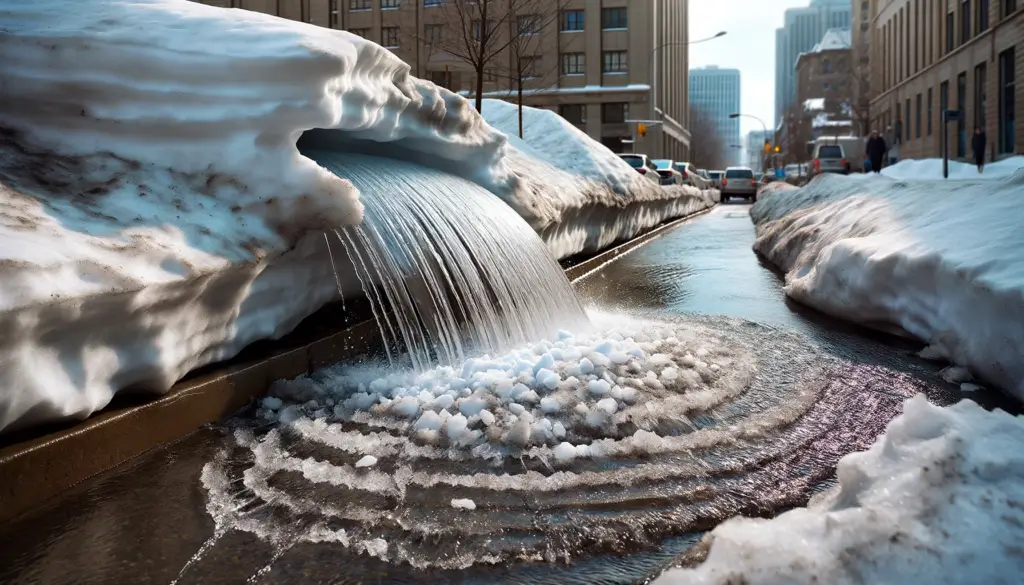Snow Volume to Water Volume Conversion Calculator
By Jack Gray, Roof Online Editor • Published December 7, 2023
Table of Contents

Introduction
From time to time we get clients who are concerned that the snow building up on their commercial low-slope roofs will melt all at once and their roof/storm drainage systems won’t be able to handle it.
It seems like it’s important to know how much water a given amount of snow could turn into.
We looked up other snow to water volume calculators, but we didn’t think they were detailed or precise enough as far as the types of snow goes (there’s a huge variability in snow densities) so we made our own calculators. Here they are.
Types of Snow and their Densities
These are the types of snow, with their average densities, that we use in the calculators below. Remember that each type of snow actually comes in a range of densities, and we are using averages for our calculations.
You can see the ranges for the snow density values in the table in our Snow Weight Calculator • Snow Density Chart • Snow Types article.
- Wild Snow: This is a type of light and very dry new snow immediately after it falls, in extremely cold temperatures, without any wind influence. The average density of this type of snow is 1.25 lb/ft³.
- Ordinary New Snow: This is snow immediately after it falls which is uncompacted, in below-freezing temperatures with no wind, characterized by a high volume of trapped air. The average density of this type of snow is 3.59 lb/ft³.
- New Snow Slightly Compacted by Wind: This is snow soon after it falls in below-freezing temperatures which has experienced some wind exposure, resulting in less trapped air. The average density of this type of snow is 4.46 lb/ft³.
- Settling Snow: This type of snow is less than a day old that is undergoing wind and temperature variations, causing it to “settle”. The average density of this type of snow is 8.12 lb/ft³.
- Damp New Snow: This is snow immediately after falling in slightly above-freezing temperatures with little wind exposure that retains a certain amount of moisture. The average density of this type of snow is 9.37 lb/ft³.
- Sugar Snow: This snow type consists of large grains formed when water vapor freezes onto existing snow crystals, giving it a sugar-like texture. The average density of this type of snow is 12.49 lb/ft³.
- Settled Snow: Typically found after more than one day in place, this snow has undergone temperature and wind variations. The average density of this type of snow is 15.61 lb/ft³.
- Average Wind-Toughened Snow: This is compacted snow that has been exposed to wind over time in below-freezing temperatures. The average density of this type of snow is 17.48 lb/ft³.
- Wet Snow: A heavier sticky snow that has experienced warmer temperatures with little wind, ideal for making snowballs. The average density of this type of snow is 21 lb/ft³.
- Wind-Packed Snow: Also known as Hard Wind Slab, this is compacted snow that has been subjected to prolonged and heavy wind exposure. The average density of this type of snow is 23.73 lb/ft³.
- New Firn Snow: Firn is a granular, icy, highly-compacted, pre-glacial snow with some ice present. The average density of this type of snow is 29.66 lb/ft³.
- Advanced Firn Snow: This is a more compacted and dense form of firn snow. The average density of this type of snow is 37.46 lb/ft³.
- Thawing Firn Snow: This type of firn snow is undergoing thawing and melting processes. The average density of this type of snow is 40.58 lb/ft³.
- Slush: This is advanced melting snow, basically a mixture of snow and water. The average density of this type of snow is 45 lb/ft³.
- Ice with Air Bubbles: This is cloudy ice that contains entrapped air bubbles. The average density of ice with air bubbles is 54 lb/ft³.
- Pure Ice: This form of ice is completely clear, containing no entrapped air. The average density of pure ice is 57.25 lb/ft³.
The maximum density of water is 62.4280 lb/ft³ and this density maximum occurs at at 39.2°F/4.0°C. Water density is very slightly less than this at other temperatures, but this is the value we’re using in the calculator.
Please see our article on water weight (with a calculator!) for more on water weight.